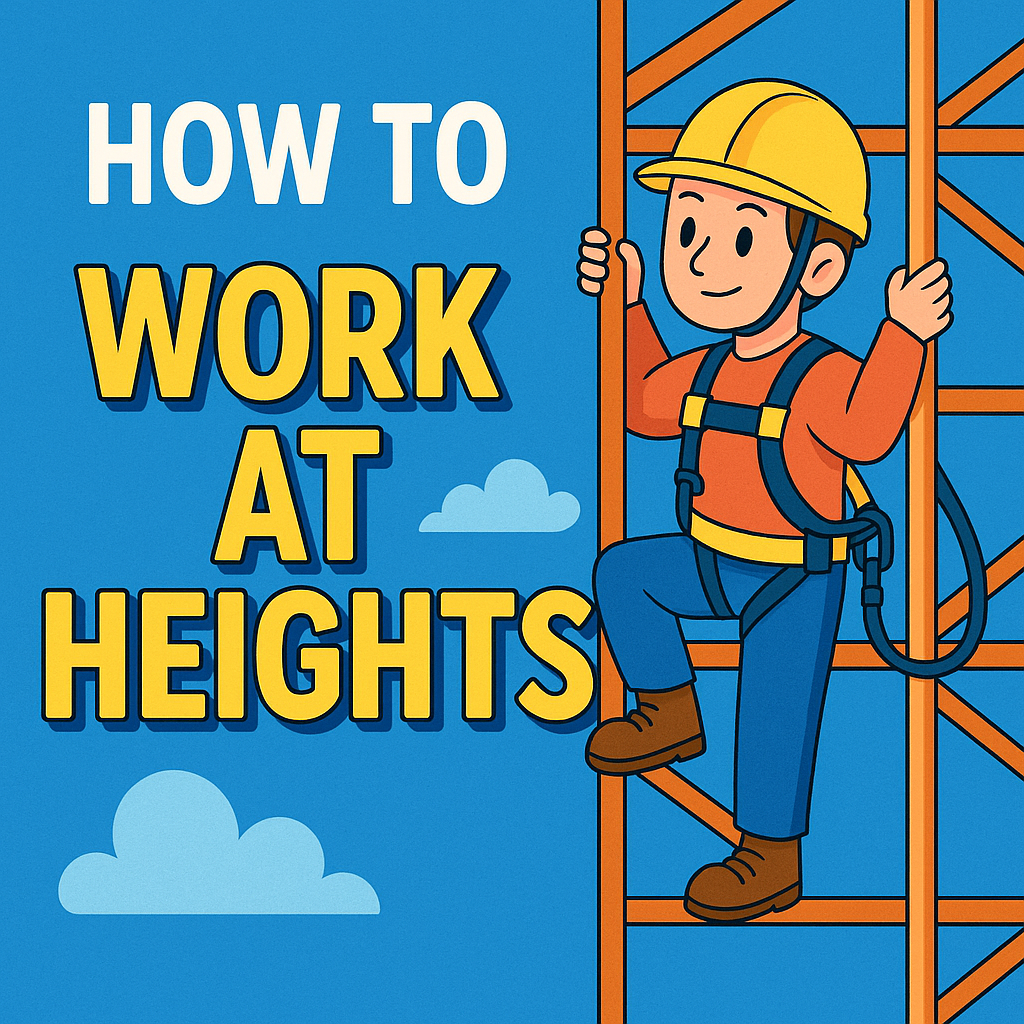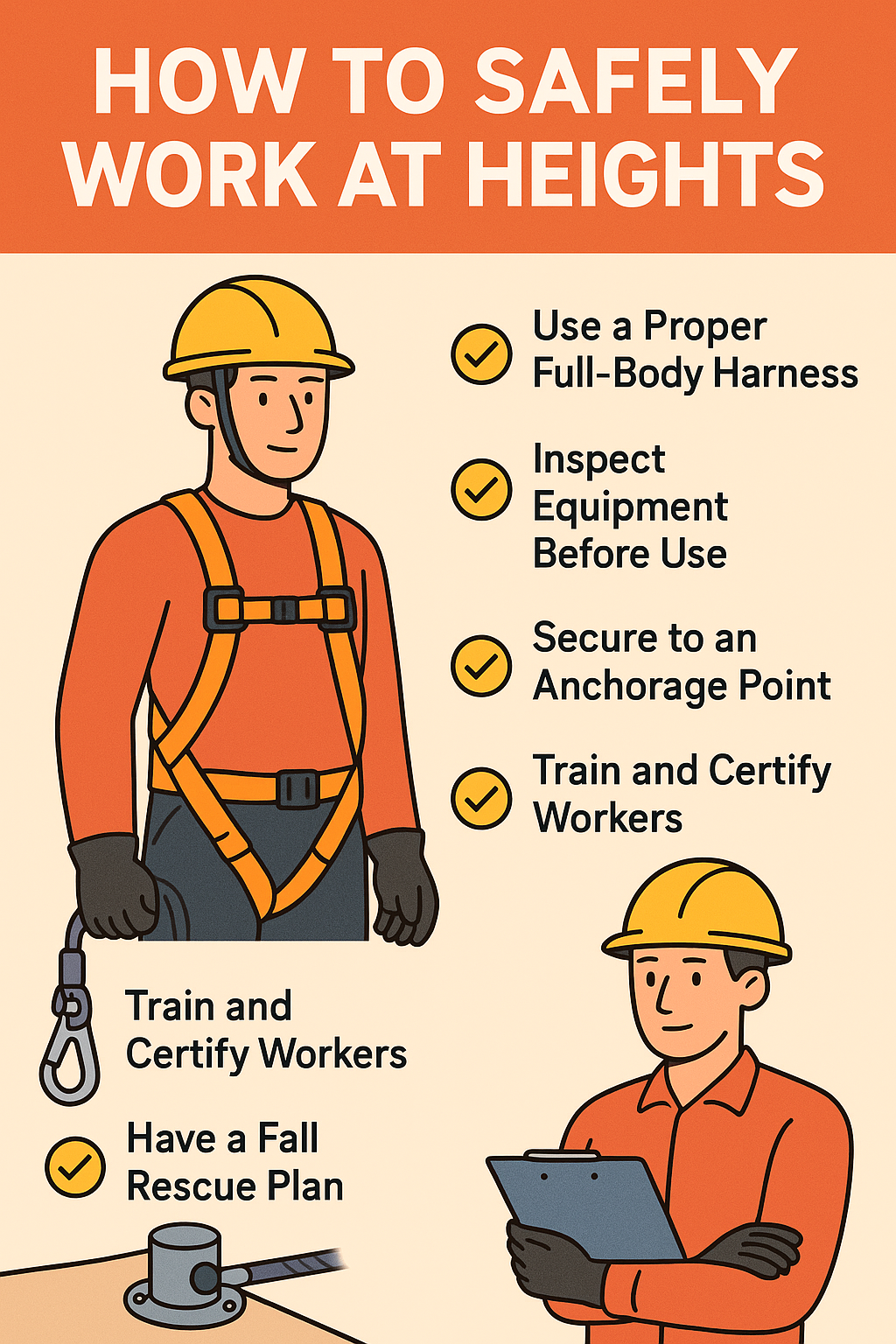- Safely Work at Heights
- 🚧 Why Fall Protection Matters
- 🧰 1. Choose the Right Fall Protection System
- 🪢 2. Use a Proper Full-Body Harness
- 🧷 3. Inspect Equipment Before Every Use
- 🧱 4. Secure to a Certified Anchorage Point
- 🔗 5. Limit Free Fall and Swing Fall Hazards
- 🪜 6. Use Fall Arrest Devices Correctly
- 📚 7. Train and Certify Workers Regularly
- 🚨 8. Have a Fall Rescue Plan in Place
- ✅ Work at Heights Safety Checklist
- 🧠 Tips for a Safe Height Work Environment
- Conclusion
Safely Work at Heights
Working at heights is one of the most dangerous activities in construction, maintenance, telecom, and other high-risk industries.
Falls from heights are a leading cause of workplace fatalities worldwide. But these tragedies are preventable with the right training, gear, and procedures.

This article covers how to safely work at heights with a focus on harness use, fall arrest systems, and essential planning for fall protection.
🚧 Why Fall Protection Matters
According to OSHA and CCOHS, falls account for thousands of injuries and dozens of deaths every year. The most common causes include:
- Lack of fall protection equipment
- Improper use of safety gear
- Unsecured ladders and platforms
- Poor training and supervision
Fall protection isn’t optional—it’s the law. In Canada, the fall protection trigger height is 3 metres (10 feet), and 6 feet under OSHA rules in the U.S.

🧰 1. Choose the Right Fall Protection System
There are three main types of fall protection systems:
1. Fall Arrest Systems
Stops a fall once it occurs. Includes a harness, lanyard, and anchorage.
2. Fall Restraint Systems
Prevents you from reaching a fall hazard (e.g., leading edge). Usually involves shorter lanyards or anchor positioning.
3. Positioning Systems
Used to hold a worker in place while allowing hands-free work (e.g., tower climbing).
Note: If there’s a chance of falling, fall arrest is the default required system.
🪢 2. Use a Proper Full-Body Harness
A full-body harness distributes the force of a fall across the shoulders, thighs, and pelvis. Key features:
- Dorsal D-ring on the back for fall arrest
- Shoulder and leg straps adjusted snugly
- Label indicating CSA/ANSI compliance
- No signs of wear, fraying, or rust on buckles
Internal link: Learn more from our post on Essential PPE for Different Job Roles
🧷 3. Inspect Equipment Before Every Use
Before using any fall protection gear, inspect:
- Harness straps for cuts, wear, or mildew
- Buckle connections for corrosion or bending
- Lanyards and self-retracting lifelines (SRLs) for fraying or damage
- D-rings for distortion or cracks
Log inspections and tag out defective gear immediately.
🧱 4. Secure to a Certified Anchorage Point
An anchorage is where your lanyard connects to support your fall arrest system. It must:
- Support at least 5,000 lbs (22 kN) per worker attached
- Be certified by a qualified engineer or safety authority
- Be at or above the D-ring level to minimize free fall distance
- Be installed away from edges or sharp corners
Avoid makeshift anchor points like piping, scaffolding frames, or guardrails not rated for fall arrest.
🔗 5. Limit Free Fall and Swing Fall Hazards
To work safely at heights, control the free fall distance (maximum 6 feet) and minimize swing fall (pendulum effect) risks:
- Keep your anchorage above or directly behind you
- Use retractable lifelines in vertical or diagonal scenarios
- Ensure there’s sufficient clearance below in case of a fall
Swing falls can cause serious injury even if your harness works correctly.
🪜 6. Use Fall Arrest Devices Correctly
Key fall arrest components include:
| Component | Function |
|---|---|
| Full-Body Harness | Distributes fall impact safely |
| Shock-Absorbing Lanyard | Reduces deceleration force on body |
| Self-Retracting Lifeline (SRL) | Locks quickly to limit free fall |
| Anchor Connector (D-Ring) | Connects lanyard to anchorage |
Each part must be compatible, rated, and properly installed.
📚 7. Train and Certify Workers Regularly
Training is not a one-time task. Workers must be trained on:
- Fall hazards and identification
- Equipment selection and inspection
- Emergency rescue procedures
- Use of ladders, scaffolds, and aerial lifts
In Canada, Working at Heights Training is required for construction workers and must be refreshed every 3 years.
Also, train workers to recognize suspension trauma and how to self-rescue or call for help quickly.
🚨 8. Have a Fall Rescue Plan in Place
A rescue plan is required by law and critical for survival. Your plan should include:
- A designated rescue team
- Emergency contacts and first-aid procedures
- Location of rescue tools (ladders, pulley systems, etc.)
- Practice drills at least twice per year
Don’t rely on emergency services alone—they may not arrive fast enough.

✅ Work at Heights Safety Checklist
| Check | Completed (✔) |
|---|---|
| Trained on fall protection | ✔ |
| Inspected harness and lanyards | ✔ |
| Anchorage point rated & secure | ✔ |
| Rescue plan available and posted | ✔ |
| Free fall and swing hazards assessed | ✔ |
🧠 Tips for a Safe Height Work Environment
- Don’t work alone at heights
- Avoid loose tools or unsecured materials
- Use toe boards and guardrails where applicable
- Keep equipment clean, dry, and properly stored
- Use spotters or radios to stay in contact
Conclusion
To safely work at heights, you must combine the right equipment, proper training, and a culture of accountability.
Every task performed above ground level should begin with planning, inspection, and understanding your fall arrest system.
Never take shortcuts. When lives are on the line, safety must be worn, tied, and anchored.

No comments yet